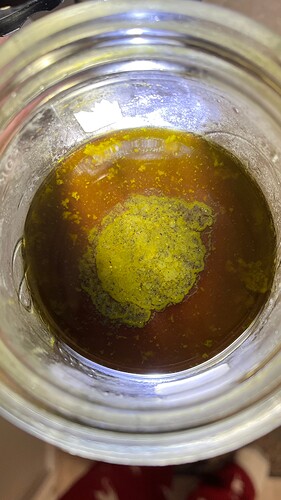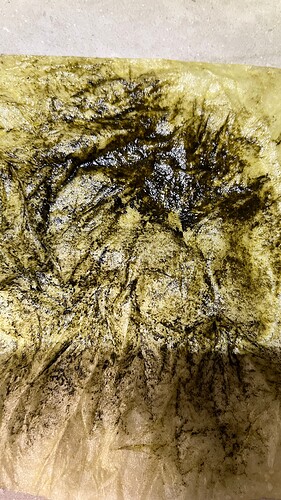Howdy, answers in order as asked, plus more…
Keep in mind all my answers are from exploring how to make a refined RSO at home. My process uses a double boiler to keep the temp down to around 180f to save terps. To your question -
Is this a room temp extraction? What you see above is a look at a warm wash jar, then winterized and filtered. I recommend QWISO & winterization, but have to handle the worst case scenarios of hour long soaks. Any soaks over a few minutes will include plant material. I’ve clarified using Alum successfully before finding Lime Juice. Moringa Seed Powder may also work.
If so, do you do brine wash? Yes, but not the way you’d expect. I wash in ISO, winterize, then pour the wash in a double boiler. The bottom pan is tap water, the wash goes in the top pan. I add 1 cup of brine to the top pan. Check out what happens when it gets hot. This was a small test run. This was an earlier run before the double boiler, thus ran much hotter…
The brine salts out the Isopropyl, then boils it off, leaving floating oil. Ta Da! Almost done… By controlling the heat of the double boiler, my wash never exceeds 185f; i try to keep it at 180f. This way, most of the terps can be saved.
After the ISO boils off, I place the top pan in the freezer till it nearly freezes. It doesn’t due to the salt saturation. The oils cling to the pan, and I can pour out the brine leaving the oil. Here’s an bigger run -
After that, I collect the oils by redissolving in EtOH, adding 1oz distilled water, then set in an oil bath do the final purge. As the EtOH evaporates, the water & oil separate. I place that back in the fridge to cool down, then pour off the water. The water carries away any remaining salts and water soluble plant material. Here’s a picture of the oil & water at the end of the first reduction.

Once the water is dumped, I redissolve in EtOH and let sit in the oil bath till the end. A Little Dipper Crock Pot is perfect for this. Its 35 watts and keeps a steady temperature around 180 degrees for the duration.

The reason I ask … will take waaaaay longer. I feel the pain. Freezing the wash increases the viscosity and the waxes plug up everything. Here’s my secret, you heard it first right here. I use a KN95 mask as my filter media, lined with a paper towel. Thats actually a paper towel you see in the prior post. N95/KN95s are rated to catch particulates down to 0.3 microns but allow fast flow! They can get plugged up quickly, so I always line them with a paper towel and that works pretty well. Best part, I can change out the paper towel in between pours. Here’s a couple pics.


I’m pretty much have completed the OP for home use. The wash with lemon juice, winterizing, distilling with brine, then doing a formal purge makes for a very robust procedure at home. By using ISO for the bulk extraction, then just a couple ounces of EtOH to clean up the final oil, this process becomes very inexpensive. By foregoing decarbing up front, the hottest temp will be 180f for the entire distilling, reduction and decarbing (10 hrs@180f) . This way, some terps can be saved.



